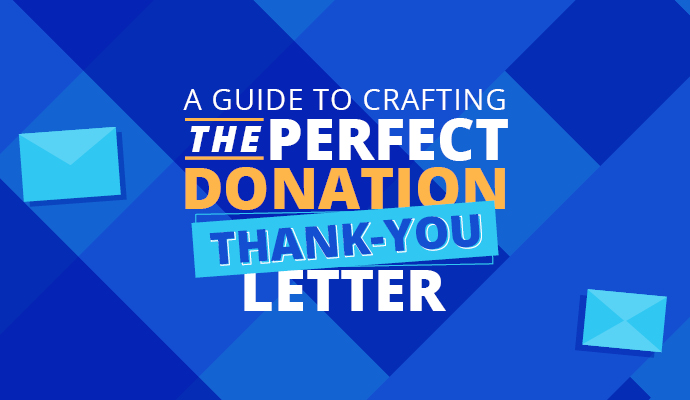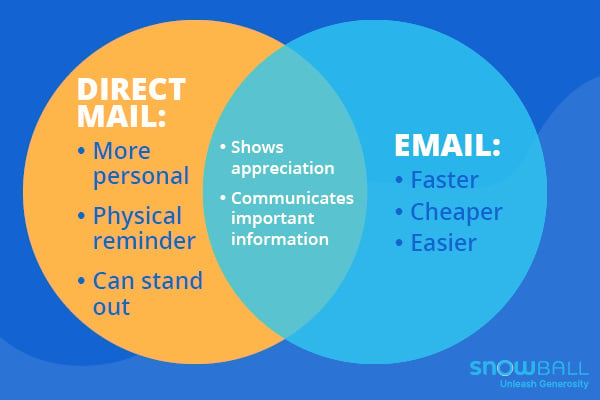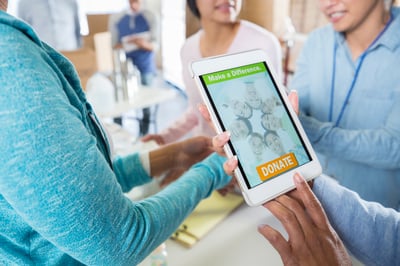November 12, 2024
 by John Killoran / November 12, 2024
by John Killoran / November 12, 2024

If you’ve ever spent time fundraising, you know that thanking your donors is one of the most important parts of the business.
After all, donor appreciation is a fundamental element necessary to grow a nonprofit organization by increasing donor retention and boosting fundraising revenue.
That’s why we’ve created this comprehensive guide to writing thank-you letters for donations. We'll cover the importance of sending a thank-you letter for donations, what goes into creating a thank-you letter using email marketing tools, templates for you to use, and examples that will leave you inspired. In the end, you will gain a better understanding of the work that goes into personally thanking donors for their contributions to your mission.
Whether you're just starting a nonprofit or you run an established organization seeking funding in a difficult time, these are some best practices you can follow to ensure success. Ready to get started? Let’s jump in!
A donation thank-you letter is a simple response of gratitude for a gift received by an individual or an organization. Typically only a few paragraphs long, thank-you letters provide an opportunity for nonprofit organizations to share their appreciation and demonstrate the impact of each donation.
Here are a few main reasons for a nonprofit to send a donation thank-you letter:
While anyone can send a donation thank-you letter (including individuals fundraising for a mission trip, medical expense, or other large cost), nonprofits and other charitable organizations most commonly write and send these types of letters.
By sending a personalized thank-you letter to each donor, you can show that your organization cares about each donation—no matter the size. This will not only boost your fundraising efforts but also strengthen relationships with supporters.
If you’re new to writing donation thank-you letters, it might seem daunting. However, an optimized thank-you letter can be simplified and broken down into eight essential components, making it a much simpler and easier-to-manage process.

Here are eight elements to include in an effective donation thank-you letter:
While some of this information is specific to the individual donor and, thus, adjusted for each letter you write (such as greeting and specific thanks), some will carry over from letter to letter (your mission, impact, and current projects).
With helpful resources like online fundraising platforms and text-to-give tools, a lot of this information can be collected automatically and extracted for your donation thank-you letters, making the process easier than ever.
Every donor deserves a thank-you letter, but making it personal, based on how often they donate, really hits home and shows you value their unique support. Consider sorting your donors into the following types for ease of customizing messages.
If you’re ready to start writing your donation thank-you letters but are unsure what to say, here’s a well-crafted template you can use for your donor correspondence. As you read carefully, you can see that this specific template incorporates each of the aforementioned essential components of an effective donation thank-you letter:
Dear [donor’s first name],
Thank you for your generous donation of [gift size in dollars] on [date of donation]. Here at [organization name], we are passionate about [brief summary of mission statement].
Your generous donation makes a positive impact on [overall goal] by [current project], [current project], and [current project]. Thanks to the money raised through [name of particular campaign or fundraiser], [number of constituents] now have access to [benefit] and [benefit].
For more information about [organization name] and how your gifts have made a difference in the community, please reach out to us by [phone number] or [email address]. We’d love to hear from you!
Yours truly,
[Full name]
[Title within organization]P.S. To learn more about the latest news at [organization name], check out our website at [URL] or follow us on [social media platform] at [username].
For more example templates, check out these free downloadable letter templates that you can customize with your own information and start sending to valuable donors!
Sometimes, the best way to understand how to do something is by looking at powerful examples that others have completed in the past. That’s why we’ve compiled these four top-tier donation thank-you letters from nonprofits like yours. Read these examples and pick out some best practices you’d like to emulate in your letters!
DonorsChoose works with students and teachers worldwide to collect and distribute valuable resources to underfunded schools. The students who receive these supplies then send personalized, heart-warming thank-you letters to the donors who support their education.
Here are two examples of thank-you letters from elementary school children demonstrating their appreciation for various donated school supplies:
Dear friends,
My brain is getting smarter from the tablet! Thank you!
Love, Liliana
Thank you so so so so…[478 more “so’s”]... SO much.
*Gasps for breath*
You should feel special. This took me 2 hours to finish all 483 “so’s.”
These simple letters are effective because they come directly from the donations' beneficiaries. Plus, children automatically add an extra layer of unique ability and personalization!
Love146 is a nonprofit organization seeking to end child trafficking by providing extensive prevention education and working with victims and survivors of child trafficking.
Here is an example of a donation thank-you letter from the organization in response to a successful #GivingTuesday campaign:
You have the power to create change. -love Sam.
This morning, I walked into the office and found a small package from students in New Jersey; they had made cards for children in our Survivor Care Program. The message from Sam stood out: you have the power to create change.
Moments later, at 9:02 am, we met our #GivingTuesday fundraising goal. I’m not joking. 9:02. We’re thankful for all of you who gave (and even for you who had the stamina to open one more charity email today and read it - bravo). Like Sam said, you have the power to create change.
Since it began in 2012, #GivingTuesday has become one of the biggest annual grassroots events for Love146. We’re thankful for every gift: from our matching donor, Super Bowl Champion Britton Colquitt and his family, to a $10 donor this morning who shared, “I donated because children should have fun and play.”
Because of your generosity, more children will be reached by our Prevention Education and Survivor Care programs. It matters for each of them that we take the power we have and use it to create change. Thanks for doing that today.
Marilyn Murray
Director of Communications, Love146
This donation thank-you letter is written with an informal, conversational tone— as if written from one friend to another. By using humor and storytelling techniques, the letter is a quick, easy, and interesting read.
In addition to a basic message of thanks, the sender also takes the time to dive into the organization’s background with #GivingTuesday as well as note specific examples of where the funding will go.
Break for Jesus is a religious organization that hosts a week-long spring break camp for children in Canada. This is an example of a donation thank-you letter written to their major sponsor, a Ukrainian credit union:
Glory to Jesus Christ!
Dear committee members -
We wish to extend our warmest thanks for your very generous donation in support of Break for Jesus Camp, which successfully ran from March 10-16th. You are our major sponsor! Over 60 children participated in a week of faith, fun and friendship at the beautiful Mount Mary Retreat Centre in Ancaster.
The Sisters welcomed us warmly, while the youth counselors and adult volunteers worked hard to make this a week where our children discovered more about their Ukrainian Catholic faith and our Byzantine traditions, and had a great time doing it.
Each child made an icon on glass (in reverse), listened to teachings, prayed, sang, played games and sports, and made many friends. A highlight was our Bishop Stephen’s visit, when after presiding over the renewal of our baptismal vows and sprinkling us all with holy water, Bishop gave everyone a box of Smarties!
B4J could not run without your help. We’re including a couple of photos of our kids. More can be seen on our website www.b4j.ca. We are also in the process of sending digital photos to be included on your website, and finding out the logistics of using UCU-approved branding in our communications materials, i.e. acknowledging your support on our website.
Thank you again for your generosity, and may God continue to bless you in this Year of Faith!
Yours in Christ,
Tanya Choly (Camp Director)
Fr. Bohdan Choly (Chaplain)
Olia Dezurevych (Administrative Director)
Instead of being addressed to a single recipient, the camp decided to write to their corporate sponsor as a whole. While this approach may be slightly less personal, they make up for it with ample detail and a specific recap of the campers’ experience— and photos!
Now that you know what to say in your donation thank-you letter, it’s just as important to use the right communication channels to convey your message. As new technology is introduced, the way organizations relate with supporters continues to evolve.
Direct mail has been a long-standing tradition of transmitting physical letters from one person to another. However, the rise of the internet and email messaging along with it has led to a new question you need to ask yourself when it comes to donor communications (and specifically thank-you letters!).

Here are some of the main advantages of each.
For most organizations, the best answer involves a combination of the two. For example, you may ask each donor to choose their preferred method of communication within the donation form. Then, you’ll have firsthand knowledge about the best strategies for each individual. If you ask for a preferred communication method, you honor that and continue building strong, lasting relationships.
There are many ways to write a donation thank-you letter; no two letters are the same. That’s why it’s a good idea to research and decide on a strategy that works best for your organization. After all, the most important part is ensuring donors feel your appreciation and understand their impact on the mission.
Want to keep your donors sticking around? Check out the top donor management tools for building those connections!
This article was originally published in 2020. It has been updated with new information.
John Killoran is an inventor, entrepreneur, and the Chairman of Clover Leaf Solutions, a national lab services company. He currently leads Clover Leaf’s investment in Snowball Fundraising, an online fundraising platform for nonprofit organizations. Snowball was one of John’s first public innovations; it’s a fundraising platform that offers text-to-give, online giving, events, and peer-to-peer fundraising tools for nonprofits. By making giving simple, Snowball increases the donations that these organizations can raise online. The Snowball effect is real! John founded Snowball in 2011. Now, it serves over 7,000 nonprofits and is the #1 nonprofit fundraising platform.
As a nonprofit professional, you've likely researched effective donor management strategies...
 by John Killoran
by John Killoran
If you work in the nonprofit world, you’ve likely seen the benefits of online fundraising.
 by Joshua Meyer
by Joshua Meyer
With nonprofit operations relying heavily on the digital fundraising sphere, it’s important to...
 by Andrew Berry
by Andrew Berry
As a nonprofit professional, you've likely researched effective donor management strategies...
 by John Killoran
by John Killoran
If you work in the nonprofit world, you’ve likely seen the benefits of online fundraising.
 by Joshua Meyer
by Joshua Meyer


